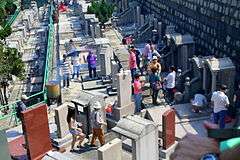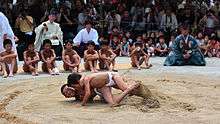Double Ninth Festival
The Double Ninth Festival (Chong Yang Festival or Chung Yeung Festival in China, Hong Kong, Macao and Taiwan, Chōyō (Japanese: 重陽, Kiku no Sekku), Jungyangjeol (Hangul: 중양절, Hanja: 重陽節), Vietnamese: Tết Trùng Cửu), observed on the ninth day of the ninth month in the Chinese calendar, is a traditional Chinese holiday, mentioned in writing since before the Eastern Han period (before AD 25).[2]
| Double Ninth Festival | |
|---|---|
 Chai Wan Cemetery, Hong Kong, 2015 | |
| Official name | Chong Yang Festival (重陽節) (重阳节)[1] |
| Also called | Chung Yeung Festival (重陽節) Chōyō (重陽) Jungyangjeol (중양절) [2][3] Chrysanthemum Festival (菊の節句) Vietnamese: Tết Trùng Cửu [4] |
| Observed by | Chinese, Japanese, Koreans, Vietnamese [2] |
| Date | 9th day of the 9th lunar month |
| 2019 date | 7 October |
| 2020 date | 25 October |
| 2021 date | 14 October |
| 2022 date | 4 October |
| Frequency | annual |
| Double Ninth Festival | |||||||||||||||||||||||||||
|---|---|---|---|---|---|---|---|---|---|---|---|---|---|---|---|---|---|---|---|---|---|---|---|---|---|---|---|
| Traditional Chinese | 重陽節 | ||||||||||||||||||||||||||
| Simplified Chinese | 重阳节 | ||||||||||||||||||||||||||
| |||||||||||||||||||||||||||
According to the I Ching, nine is a yang number; the ninth day of the ninth lunar month (or double nine) has too much yang (a traditional Chinese spiritual concept) and is thus a potentially dangerous date. Hence, the day is also called "Double Yang Festival" (重陽節). To protect against danger, it is customary to climb a high mountain, drink chrysanthemum liquor, and wear the zhuyu (茱萸) plant, Cornus officinalis. (Both chrysanthemum and zhuyu are considered to have cleansing qualities and are used on other occasions to air out houses and cure illnesses.)
On this holiday some Chinese also visit the graves of their ancestors to pay their respects. In Hong Kong and Macao, whole extended families head to ancestral graves to clean them and repaint inscriptions, and to lay out food offerings such as roast suckling pig and fruit, which are then eaten (after the spirits have consumed the spiritual element of the food). Chongyang Cake is also popular. Incense sticks are burned.[5] Cemeteries get crowded, and each year grass fires are inadvertently started by the burning incense sticks.
Origin
Once there was a man named Heng Jing, who believed that a monster would bring pestilence. He told his countrymen to hide on a hill while he went to defeat the monster. Later, people celebrated Heng Jing's defeat of the monster on the ninth day of the ninth lunar month.
In 1966, Taiwan rededicated the holiday as "Senior Citizens' Day",[6] underscoring one custom as it is observed in China, where the festival is also an opportunity to care for and appreciate the elderly.[7]
Double Ninth may have originated as a day to drive away danger, but like the Chinese New Year, over time it became a day of celebration. In contemporary times it is an occasion for hiking and chrysanthemum appreciation.[1] Other activities include flying kites, making flower cakes, and welcoming married daughters back home for visiting.[1] Stores sell rice cakes (糕 "gāo", a homophone for height 高) with mini colorful flags to represent zhuyu. Most people drink chrysanthemum tea, while a few traditionalists drink homemade chrysanthemum wine. Children learn poems about chrysanthemums, and many localities host chrysanthemum exhibits. Mountain climbing races are also popular; winners get to wear a wreath made of zhuyu. In Shandong province people drink spicy radish soup to bring good luck, it comes from an old saying " 喝了萝卜汤,全家不遭殃" (Hēle luóbo tāng, quánjiā bù zāoyāng/Drink the carrot soup, the whole family will not suffer).
Festivities
Japan

In Japan, the festival is known as Chōyō but also as the Chrysanthemum Festival (菊の節句, Kiku no Sekku) and it is one of the Japan's five sacred ancient festivals (sekku).[8][9][10] It is most commonly celebrated on the 9th day of the 9th month according to the Gregorian calendar rather than the lunar calendar, i.e. on September 9. It is celebrated at both Shinto shrines and Buddhist temples.[11] The festival is celebrated in the wish for the longevity of one's life and is observed by drinking chrysanthemum sake and eating dishes such as chestnut rice or (kuri-gohan) and chestnuts with glutinous rice or (guri-mochi).[10]
Korea
In Korea, the festival is known as Jungyangjeol (중양절) and it is celebrated on the 9th day of the 9th month.[3] Koreans would consume chrysanthemum leaves in pancakes. As the festival is meant to celebrate and cultivate good health, outdoor activities such as carrying dogwood, climbing hills or mountains for picnics as well as gazing at chrysanthemum blossoms are carried out.[2][3]
Poem
There is an oft-quoted poem about the holiday, Double Ninth, Remembering my Shandong Brothers (九月九日憶山東兄弟), by the Tang Dynasty poet Wang Wei:
獨在異鄉為異客,
dú zài yì xiāng wéi yì kè
每逢佳節倍思親。
měi féng jiā jié bèi sī qīn
遙知兄弟登高處,
yáo zhī xiōng dì dēng gāo chù
遍插茱萸少一人。
biàn chā zhū yú shǎo yì rén
Being Alone alien in a foreign land,
Every holiday is accompanied by reminiscences of one's kith and kin.
Knowing from afar, the heights one's elder and younger brothers have scaled;
Side Wearing Cornus officinalis, there is one soul less, amiss.
See also
- Double Seventh Festival
- Qingming Festival, a day to visit and clean up the cemeteries
- Curse of the Golden Flower, a Chinese film in which the plot takes place around the Chrysanthemum Festival.
 Participants arrive at the Chai Wan Cemetery, Hong Kong, 2015
Participants arrive at the Chai Wan Cemetery, Hong Kong, 2015 Chai Wan Cemetery Hong Kong, 2015
Chai Wan Cemetery Hong Kong, 2015 Chai Wan Cemetery, Hong Kong, 2015
Chai Wan Cemetery, Hong Kong, 2015 Xian Tang Village, Dongguan, China, 2015
Xian Tang Village, Dongguan, China, 2015 Xian Tang Village, Dongguan, China, 2015
Xian Tang Village, Dongguan, China, 2015
References
- Zhao, Rongguang (2015). A History of Food Culture in China. SCPG Publishing Corporation. p. 14. ISBN 978-1938368165.
- Roy, Christian (2004). Traditional Festivals: A Multicultural Encyclopedia. pp. 116. ISBN 978-1576070895.
- National Folk Museum of Korea (2015). Encyclopedia of Korean Seasonal Customs: Encyclopedia of Korean Folklore and Traditional Culture. Gil-Job-Ie Media. p. 232.
- https://lichvannien365.com/tet-trung-cuu-su-that-va-y-nghia-cua-no.html
- Chung Yueng Festival, Discover Hong Kong
- "Chrysanthemums, Climbing, and Consideration of the Elderly - Double Ninth Day". Gio.gov.tw. Archived from the original on May 15, 2008. Retrieved 2008-10-07.
- "Archived copy". Archived from the original on 2007-10-28. Retrieved 2007-10-25.CS1 maint: archived copy as title (link)
- "Chrysanthemum Festival". The Free Dictionary. 2010. Retrieved 2015-06-08.
- 菊の節句(重陽の節句) [The Chrysanthemum Festival (The Choyo Festival)] (in Japanese). 英語対訳で読む日本の文化. Retrieved 7 November 2018.
- "Chapter 3: Kiku no sekku". Japan Federation of Pottery Wholesalers’ Co-operative Association. 3 June 2016. Retrieved 7 November 2018.
- "Autumn (July - September)". Tokyo Metropolitan Library. Retrieved 7 November 2018.
